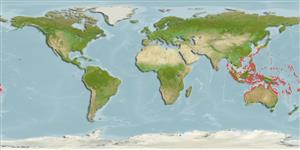Common names from other countries
>
Blenniiformes (Blennies) >
Tripterygiidae (Triplefin blennies) > Tripterygiinae
Etymology: Helcogramma: Greek, helkos, -eos, -ous = ulcer, sore + Greek, gramma = letter, mark (Ref. 45335).
Environment: milieu / climate zone / depth range / distribution range
экология
морской демерсальный; пределы глубины 0 - 6 m (Ref. 90102). Tropical
Western Pacific: Widespread in the area, from the Philippines, Viet Nam, Indonesia (Borneo) to the Solomon Islands (Ref. 13227). Recently collected from Fiji and Tonga (Williams pers. comm.). New locality records from Thailand and the Andaman Sea (Ref. 27223).
Size / Вес / Возраст
Maturity: Lm ? range ? - ? cm
Max length : 4.0 cm TL самец/пол неопределен; (Ref. 48636)
Краткое описание
определительные ключи | морфология | морфометрия
колючие лучи спинного плавника (общее число) : 17 - 18; членистые (мягкие) лучи спинного плавника (общее число) : 10 - 11; колючие лучи анального плавника: 1; членистые (мягкие) лучи анального плавника: 20; позвонки: 37. Trunk without longitudinal stripes; symphyseal dentary pores 1; upper lip with proboscis-like extension on males, head with horizontal yellowish or bluish white line from the upper rim of upper jaw to opercle (Ref. 94457). Males are easily recognized by the extended nose and change color to display to females with an electric blue line below the eye, shaded by black below (Ref. 48636). Also Ref. 94101.
Adults inhabit clear coastal reefs with algae covered rocky boulders, usually in small groups (Ref. 48636). They occur in very shallow depths on rock surfaces and under ledges (Ref. 48636). Eggs are hemispherical and covered with numerous sticky threads that anchor them in the algae on the nesting sites (Ref. 240). Larvae are planktonic which occur primarily in shallow, nearshore waters (Ref. 94114). Minimum depth of 0 m reported from Ref. 58018.
Life cycle and mating behavior
Maturities | размножение | Spawnings | Egg(s) | Fecundities | личинки
Fricke, R., 1994. Tripterygiid fishes of Australia, New Zealand and the southwest Pacific Ocean (Teleostei). Theses Zool. 24:1-585. (Ref. 13227)
Статус Красного Списка МСОП (Ref. 130435)
CITES (Ref. 128078)
Not Evaluated
Угроза для людей
Harmless
Использование человеком
рыболовство: интереса не представляет; аквариум: потенциал
дополнительная информация
инструменты
Специальные отчеты
Скачать в формате XML
ресурсы в Интернет
Estimates based on models
Preferred temperature (Ref.
115969): 25 - 29.3, mean 28.6 (based on 2065 cells).
Phylogenetic diversity index (Ref.
82804): PD
50 = 0.5000 [Uniqueness, from 0.5 = low to 2.0 = high].
Bayesian length-weight: a=0.00562 (0.00258 - 0.01228), b=3.08 (2.89 - 3.27), in cm Total Length, based on LWR estimates for this (Sub)family-body shape (Ref.
93245).
Trophic level (Ref.
69278): 3.0 ±0.3 se; based on size and trophs of closest relatives
устойчивость к внешним воздействиям (Ref.
120179): высокий, минимальное время удвоения популяции до 15 месяцев (Preliminary K or Fecundity.).
Fishing Vulnerability (Ref.
59153): Low vulnerability (10 of 100).
